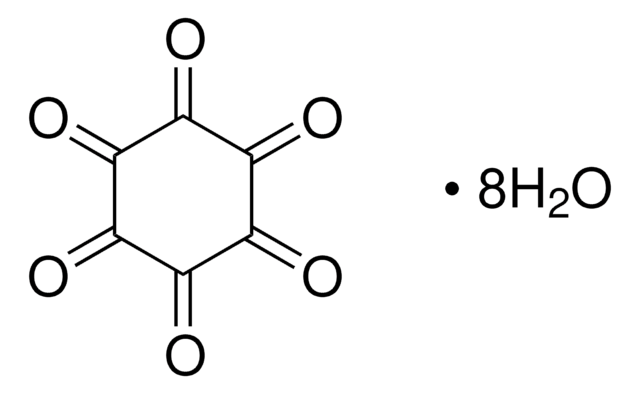230898
Antimony(III) oxide
powder, 5 μm, ReagentPlus®, 99%
Sinónimos:
Diantimony trioxide
Iniciar sesiónpara Ver la Fijación de precios por contrato y de la organización
About This Item
Fórmula lineal:
Sb2O3
Número de CAS:
Peso molecular:
291.52
Número CE:
Número MDL:
Código UNSPSC:
12352303
eCl@ss:
38080202
ID de la sustancia en PubChem:
NACRES:
NA.23
Productos recomendados
Línea del producto
ReagentPlus®
Ensayo
99%
Formulario
powder
tamaño de partícula
5 μm
bp
1550 °C (lit.)
mp
655 °C (lit.)
cadena SMILES
O=[Sb]O[Sb]=O
InChI
1S/3O.2Sb
Clave InChI
ADCOVFLJGNWWNZ-UHFFFAOYSA-N
¿Está buscando productos similares? Visita Guía de comparación de productos
Aplicación
- Thermal Decomposition and Carbothermal Reduction: Examines the recycling and purification processes of Antimony(III) oxide from metal oxides, valuable for those interested in sustainable metallurgy (Karlsson et al., 2018).
- Oxidation of Antimony(III) in Soil by Manganese(IV) Oxide: Studies the interaction between manganese oxide and antimony(III) oxide in soils, providing insights into environmental chemistry and soil remediation (Fu et al., 2018).
- Adsorption of Antimony(V) onto Mn(II)-Enriched Surfaces: Focuses on how manganese oxide interacts with antimony(V), relevant for those studying adsorption processes and water treatment technologies (Liu et al., 2015).
- Kinetic Modeling of Antimony(III) Oxidation and Sorption in Soils: Provides a kinetic model of antimony(III) interactions with environmental matrices, useful for environmental scientists and chemists involved in pollution control (Cai et al., 2016).
Información legal
ReagentPlus is a registered trademark of Merck KGaA, Darmstadt, Germany
Palabra de señalización
Warning
Frases de peligro
Consejos de prudencia
Clasificaciones de peligro
Carc. 2
Código de clase de almacenamiento
13 - Non Combustible Solids
Clase de riesgo para el agua (WGK)
WGK 1
Punto de inflamabilidad (°F)
Not applicable
Punto de inflamabilidad (°C)
Not applicable
Equipo de protección personal
Eyeshields, Gloves, type P3 (EN 143) respirator cartridges
Elija entre una de las versiones más recientes:
¿Ya tiene este producto?
Encuentre la documentación para los productos que ha comprado recientemente en la Biblioteca de documentos.
Los clientes también vieron
[Report on analysis of lung biopsy of pneumoconiosis exposed to antimony trioxide].
Xiao-ping Li et al.
Zhonghua lao dong wei sheng zhi ye bing za zhi = Zhonghua laodong weisheng zhiyebing zazhi = Chinese journal of industrial hygiene and occupational diseases, 26(4), 237-238 (2008-08-30)
R O Jenkins et al.
Human & experimental toxicology, 17(4), 231-238 (1998-06-09)
1. The aerobic filamentous fungus S. brevicaulis IMI 17297 methylated antimony from Sb2O3 substrate, with the formation of gaseous trimethylantimony (TMA). No evidence was found for the generation of other gaseous antimony compounds by this organism. 2. Biovolatilization of inorganic
Y Zhong et al.
Guang pu xue yu guang pu fen xi = Guang pu, 20(2), 232-236 (2003-09-05)
An ICP-AES method was established for the simultaneous determination of Hg and As in crude antimony trioxide. The samples with different grades were digested in hydrochloric acid-tartraic acid-potassium chloride using microwave process system. The method is applied to analyze crude
Anal K Jha et al.
Biotechnology journal, 4(11), 1582-1585 (2009-10-22)
A low-cost green and reproducible microbe (Lactobacillus sp.)-mediated biosynthesis of Sb(2)O(3) nanoparticles is reported. The synthesis was performed at around room temperature. X-ray and transmission electron microscopy analyses were performed to ascertain the formation of Sb(2)O(3) nanoparticles. X-ray analysis indicated
P M Hext et al.
Journal of applied toxicology : JAT, 19(3), 205-209 (1999-06-11)
Diets containing antimony trioxide were fed to male and female Wistar rats of the Alpk:APSD strain over 90 days. Dose levels were 0 (control), 1000, 5000 and 20,000 ppm (equivalent to mean daily doses of 84, 421 and 1686 mg
Nuestro equipo de científicos tiene experiencia en todas las áreas de investigación: Ciencias de la vida, Ciencia de los materiales, Síntesis química, Cromatografía, Analítica y muchas otras.
Póngase en contacto con el Servicio técnico











